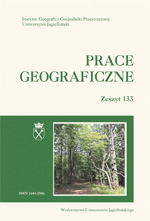Warunki biotermiczne w Tatrach Polskich
Biothermal conditions in the Polish Tatra Mountains
Author(s): Sebastian Pełech Subject(s): Cultural Essay, Political Essay, Societal Essay
Published by: Wydawnictwo Uniwersytetu Jagiellońskiego
Keywords: Subjective Temperature Index; biothermal conditions; Polish Tatra Mts.
Summary/Abstract: The paper covers a study of biothermal conditions in the Polish Tatras using daily values of the Subjective Temperature Index (STI) from three weather stations: Zakopane (foot of the mountains), Hala Gąsienicowa (tree line) and Kasprowy Wierch (summits), recorded during the period 2001–2010. The paper discusses the frequency of various thermal sensations in individual months and seasons. Biothermal conditions were demonstrated to follow an expected vertical pattern of change resembling that of the fall in air temperature. The higher the altitude the fewer STI classes remained, from six at Zakopane to four at Kasprowy Wierch, the more frequent were the sensations of cold (“cold”, “cool”) and the less frequent those linked to warmth (“hot”, “very hot”). At Zakopane and Hala Gąsienicowa the dominant thermal sensation during the year was “cool ” ( 44 and 45 %, respectively ), while “cold ” dominated at Kasprowy Wierch ( 48 % ). Zakopane had the best biothermal conditions of the three stations with “cool ”, “comfortable ” and “warm ” sensations, regarded as suitable for outdoor activities (sports and recreation) recorded throughout nearly all the year. At the opposite end of the scale were the conditions at Kasprowy Wierch, which had the highest number of days with the “cold” sensation, up to 70% on average in winter. These conditions require special clothing with a high thermal insulation factor and hand and face protection against potential frostbite.
Journal: Prace Geograficzne
- Issue Year: 2013
- Issue No: 133
- Page Range: 7-19
- Page Count: 14
- Language: Polish

